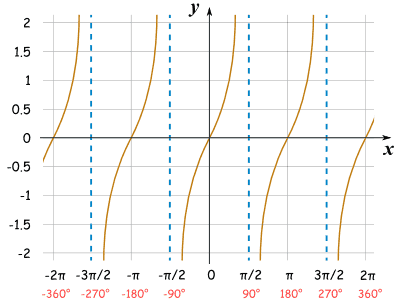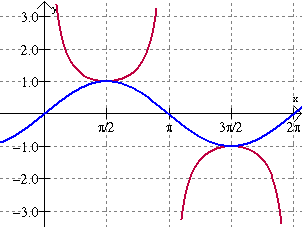Tangent?
The graphs of sine and cosine relate to tangent in contrasting and comparing ways. They all begin positive in the first quadrant. However, in sine and cosine, they are π/2 apart in the intervals that they cross the x-axis, and the distance they are apart when on the same graph. The tangent graph,however, at the π intervals, is undefined due to the prevalence of asymptotes when x=0 and due to that value along that asymptote possibly being infinitely positive or infinitely negative. We see the tangent graph that, instead of the line going horizontally infinitely, goes vertically infinite with a range of (-∞,∞).
http://www.mathsisfun.com/algebra/trig-sin-cos-tan-graphs.html
Cotangent?
In the case of cotangent, its graph goes downhill. Therefore, in comparison with the graphs of sine and cosine, whose graphs start out positive, cotangent beings at a negative angle. This assumes that all graphs start at a value of a=0. Cotangent, being an inverse of tangent, of course will still have asymptotes. The asymptotes are still the same distance as they were for a cotangent graph, π. The difference with tangent is that cotangent has asymptotes where y=0, or where sin equals 0.
Secant?
To graph a secant graph, just do the same thing you do with the cosine graph. The difference here is that the secant graph has parabolas drawn at the mountains and valleys of the shifted parent graph. Also, secant graphs have asymptotes at π/2 with a period of π, meaning that they repeat their asymptotes every π distance. due to their asymptotes, the parabolas can not pass them and thus go continuously upward or downward, as described in the picture below. Unlike sine and cosine graphs, a secant graph, just like tangent, cotangent, etc. does not have an amplitude because the graph goes continuously downwards or upwards, as aforementioned.
Cosecant?
Cosecant graphs are just like sine graphs, but like secant, has vertical asymptotes and parabolas after we graph the parent graph and its shifts. We draw the parabolas at the mountains and valleys of the graph just like the secant graph. The difference between cosecant and secant is that in one period, a cosecant graph has two parabolas instead of secant which has 1 parabola going downwards and 2 half-parabolas going upwards. I say that they are half-parabolas because the asymptote within one period limits it. If we were to graph more asymptotes the parabola would of course be whole. The cosecant graph has asymptotes have asymptotes which occur at π every π unit, as shown in the below video.
http://www.regentsprep.org/Regents/math/algtrig/ATT7/othergraphs.htm
References:
http://www.regentsprep.org/Regents/math/algtrig/ATT7/othergraphs.htm
http://www.mathsisfun.com/algebra/trig-sin-cos-tan-graphs.html




No comments:
Post a Comment